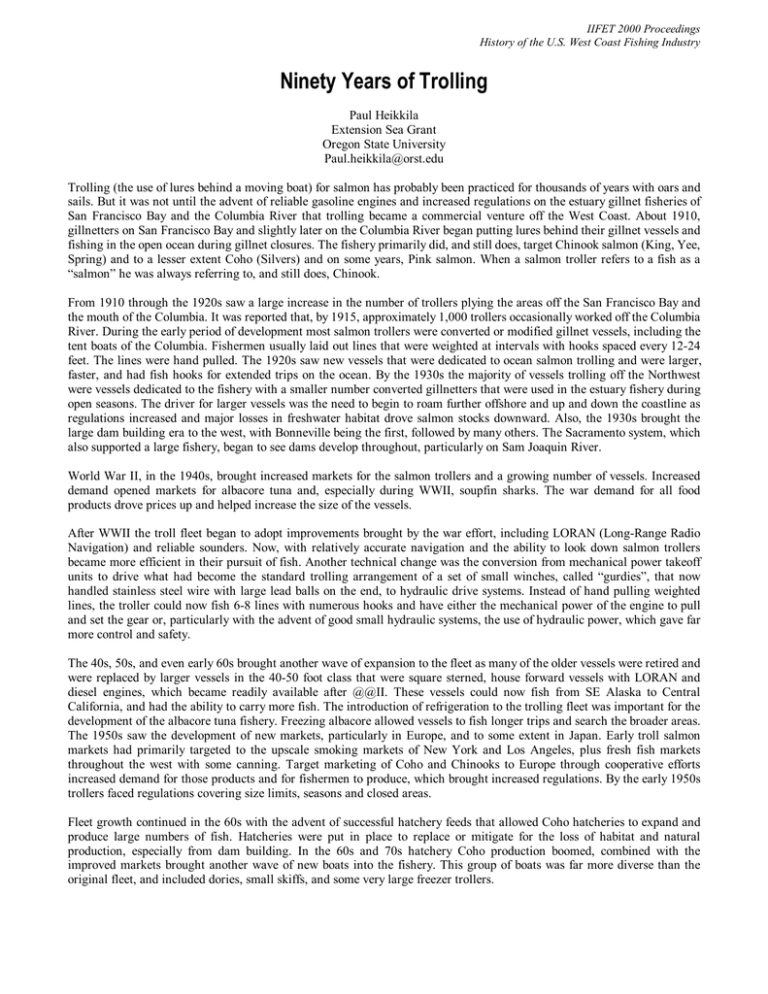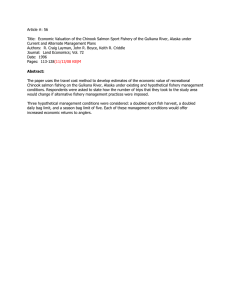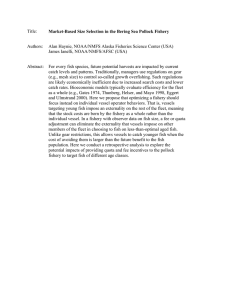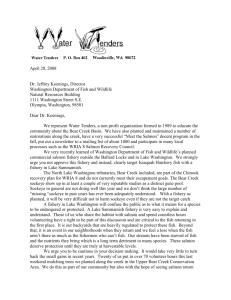Ninety Years of Trolling
advertisement

IIFET 2000 Proceedings History of the U.S. West Coast Fishing Industry Ninety Years of Trolling Paul Heikkila Extension Sea Grant Oregon State University Paul.heikkila@orst.edu Trolling (the use of lures behind a moving boat) for salmon has probably been practiced for thousands of years with oars and sails. But it was not until the advent of reliable gasoline engines and increased regulations on the estuary gillnet fisheries of San Francisco Bay and the Columbia River that trolling became a commercial venture off the West Coast. About 1910, gillnetters on San Francisco Bay and slightly later on the Columbia River began putting lures behind their gillnet vessels and fishing in the open ocean during gillnet closures. The fishery primarily did, and still does, target Chinook salmon (King, Yee, Spring) and to a lesser extent Coho (Silvers) and on some years, Pink salmon. When a salmon troller refers to a fish as a “salmon” he was always referring to, and still does, Chinook. From 1910 through the 1920s saw a large increase in the number of trollers plying the areas off the San Francisco Bay and the mouth of the Columbia. It was reported that, by 1915, approximately 1,000 trollers occasionally worked off the Columbia River. During the early period of development most salmon trollers were converted or modified gillnet vessels, including the tent boats of the Columbia. Fishermen usually laid out lines that were weighted at intervals with hooks spaced every 12-24 feet. The lines were hand pulled. The 1920s saw new vessels that were dedicated to ocean salmon trolling and were larger, faster, and had fish hooks for extended trips on the ocean. By the 1930s the majority of vessels trolling off the Northwest were vessels dedicated to the fishery with a smaller number converted gillnetters that were used in the estuary fishery during open seasons. The driver for larger vessels was the need to begin to roam further offshore and up and down the coastline as regulations increased and major losses in freshwater habitat drove salmon stocks downward. Also, the 1930s brought the large dam building era to the west, with Bonneville being the first, followed by many others. The Sacramento system, which also supported a large fishery, began to see dams develop throughout, particularly on Sam Joaquin River. World War II, in the 1940s, brought increased markets for the salmon trollers and a growing number of vessels. Increased demand opened markets for albacore tuna and, especially during WWII, soupfin sharks. The war demand for all food products drove prices up and helped increase the size of the vessels. After WWII the troll fleet began to adopt improvements brought by the war effort, including LORAN (Long-Range Radio Navigation) and reliable sounders. Now, with relatively accurate navigation and the ability to look down salmon trollers became more efficient in their pursuit of fish. Another technical change was the conversion from mechanical power takeoff units to drive what had become the standard trolling arrangement of a set of small winches, called “gurdies”, that now handled stainless steel wire with large lead balls on the end, to hydraulic drive systems. Instead of hand pulling weighted lines, the troller could now fish 6-8 lines with numerous hooks and have either the mechanical power of the engine to pull and set the gear or, particularly with the advent of good small hydraulic systems, the use of hydraulic power, which gave far more control and safety. The 40s, 50s, and even early 60s brought another wave of expansion to the fleet as many of the older vessels were retired and were replaced by larger vessels in the 40-50 foot class that were square sterned, house forward vessels with LORAN and diesel engines, which became readily available after @@II. These vessels could now fish from SE Alaska to Central California, and had the ability to carry more fish. The introduction of refrigeration to the trolling fleet was important for the development of the albacore tuna fishery. Freezing albacore allowed vessels to fish longer trips and search the broader areas. The 1950s saw the development of new markets, particularly in Europe, and to some extent in Japan. Early troll salmon markets had primarily targeted to the upscale smoking markets of New York and Los Angeles, plus fresh fish markets throughout the west with some canning. Target marketing of Coho and Chinooks to Europe through cooperative efforts increased demand for those products and for fishermen to produce, which brought increased regulations. By the early 1950s trollers faced regulations covering size limits, seasons and closed areas. Fleet growth continued in the 60s with the advent of successful hatchery feeds that allowed Coho hatcheries to expand and produce large numbers of fish. Hatcheries were put in place to replace or mitigate for the loss of habitat and natural production, especially from dam building. In the 60s and 70s hatchery Coho production boomed, combined with the improved markets brought another wave of new boats into the fishery. This group of boats was far more diverse than the original fleet, and included dories, small skiffs, and some very large freezer trollers. IIFET 2000 Proceedings History of the U.S. West Coast Fishing Industry That era came to a crashing close in the mid 1970s, as wild stocks continued to plummet and hatchery production became very erratic. With the large number of vessels and the decrease in production, there was increasing concern about overcapitalization in the fishery and the states of Washington, Oregon and California introduced entry systems to the fishery by the late 1970s. In 1979, when limited entry was introduced in Oregon, there were approximately 3,200 trolling licenses. By 1998 the number had decreased to slightly over 1,000, with only about 300-400 active vessels in the fishery. The 1980s brought a continued downturn in production of salmon, driven by changing ocean conditions and deteriorating freshwater habitat from dams, pollution, urbanization, and many other causes. By the 1990s trolling in many areas, including the northern California, southern Oregon, and the Washington coasts had been completely shutdown or severely restricted to protect threatened stocks of Coho and Chinook, particularly those Chinook who migrated far into the watershed, such as Snake River stocks. By the mid 90s what was left of the trolling fleet in Oregon, Washington and California had stabilized at approximately 1,000 boats. Though because of good productivity from Sacramento hatcheries and wild fall Chinook, Oregon coast wild Chinook and some Columbia River hatchery production, trolling for Chinook is still a viable alternative for west coast fishermen. Many trollers in the 90s not only fish salmon during the open seasons, but also expand to albacore tuna during the late summer and fall, and may also fish crab in the winter or utilize other work. Another factor which cut trolling effort was the advent of large-scale production of Atlantic salmon from pen-rearing aquaculture operations. By 1995 the large volumes of pen-reared fish had overtaken some of the traditional troll salmon markets, such as Europe and smoked fish markets and prices began to plummet. As an example, 1988 prices for large Chinook on the Oregon coast averaged approximately $3.00 per pound ex-vessel, whereas in 1998 prices averaged approximately $1.70 per pound ex-vessel. But with the increasing public demand for wild fish harvested on a sustainable basis, markets have improved the last two years of the decade. The turn of the century finds salmon trolling still actively pursued from Monterey Bay to Neah Bay. Though the boat numbers have shrunk from the heydays and the market is competitive, trolling for Chinook, in particular, is still a viable option for the approximately 1,000 vessels that make a fair share of their income from the venture. 2






